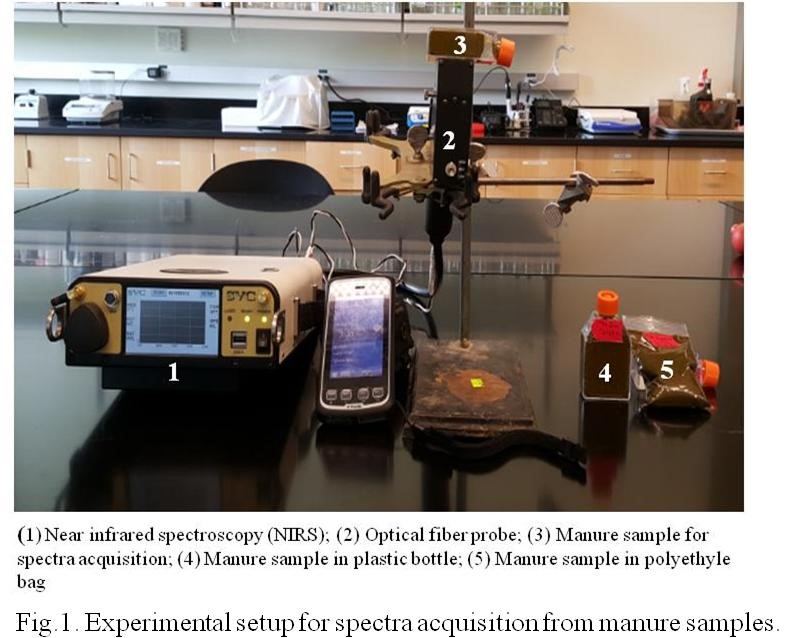Proceedings Home | W2W Home 
Purpose
Precision application of manure in agricultural land requires information on its nutrients but the existing reliable nutrient estimation methods are unsuitable for real-time nutrient levels estimation. Near infrared spectroscopy (NIRS) is a rapid, non-destructive method of composition analyses and is commonly used in agricultural plant and produce quality evaluations.Previous studies have shown potential of NIRS for manure nutrients determination without identifying specific or narrow bands suitable to predict manure nutrients (nitrogen (N), phosphorus (P), etc.). In order to develop miniaturized sensing modules for variable rate manure nutrients applications, research is needed to determine specific wavelengths suitable for predicting the nutrients. The main goal of this study was thus to develop a robust method to determine specific key wavelengths in NIR region for manure nutrients determination.
What did we do?
We investigated optical sensing integrated multivariate data analysis methods to identify key wavelengths for manure nutrients determination. Total of 150 spectra (700-2500 nm) were collected using 30 different dairy manure samples. Manure samples at various dry matter contents ranging between 0.25 to 14.0%, representing different nutrient concentrations, were prepared by diluting (1.2-56.0 times) stock manure with distilled water. During data preprocessing, the spectral data were normalized and binned (25 nm). Then, key wavelengths were selected using stepwise multiple linear regression (SMLR) followed by principal component analysis (PCA). The selected key wavelengths were evaluated using linear (partial least square regression (PLSR)) and non-linear regression models (support vector machine regression (SVMR), and artificial neural network regression (ANNR).

What have we learned?
This study demonstrates the potential use of NIRS technology for rapid detection of dairy manure nutrients. Preprocessing the
spectral data (normalizing and binning) and using the SMLR analysis followed by PCA can be an effective method for identifying key wavelengths related to manure nutrients. Ten key wavelengths identified for N and P determinations in dairy manure were 713.0, 740.6, 768.6, 964.7, 1022.9, 1144.7, 1175.1, 1295.5, 1532.7, and 1849.5 nm. The ANNR model had the highest R2 and lowest RMSE than the other two models. Similarly, the ANNR model maintained almost same performance with a set of selected key bands excluding > 1200 nm. Overall, results from this study indicated potential for development of a low-cost NIR-based sensing module for variable rate manure applications.
Future Plans
The next steps include evaluating the selected key wavelengths using a large number of manure samples from different dairy farms. This is necessary because the composition of manure is highly variable depending on the animal breed, the type of housing, the amount of water added, the type and the age of the animals, the feed rations, and the type and duration of slurry storage. We expect that this step will lead to the building of prototype modules and further field evaluation before commercialization.
Corresponding author, title, and affiliation
Pius Ndegwa, Associate Professor, Department of Biological Systems Engineering, Washington State university, Pullman, WA
Corresponding author email
Other authors
Gopi K. Kafle, Lav R. Khot, Iftikhar Zeb; Department of Biological Systems Engineering, Washington State University, Pullman, WA
Additional information
http://csanr.wsu.edu/grants/rapid-sensing-of-dairy-manure-nutrients-for-…
Acknowledgements
This research was funded by the BIOAg program via the Center for Sustainable Ag and Natural Resources and the Agricultural Research Center, Washington State University, WA.
The authors are solely responsible for the content of these proceedings. The technical information does not necessarily reflect the official position of the sponsoring agencies or institutions represented by planning committee members, and inclusion and distribution herein does not constitute an endorsement of views expressed by the same. Printed materials included herein are not refereed publications. Citations should appear as follows. EXAMPLE: Authors. 2017. Title of presentation. Waste to Worth: Spreading Science and Solutions. Cary, NC. April 18-21, 2017. URL of this page. Accessed on: today’s date.


